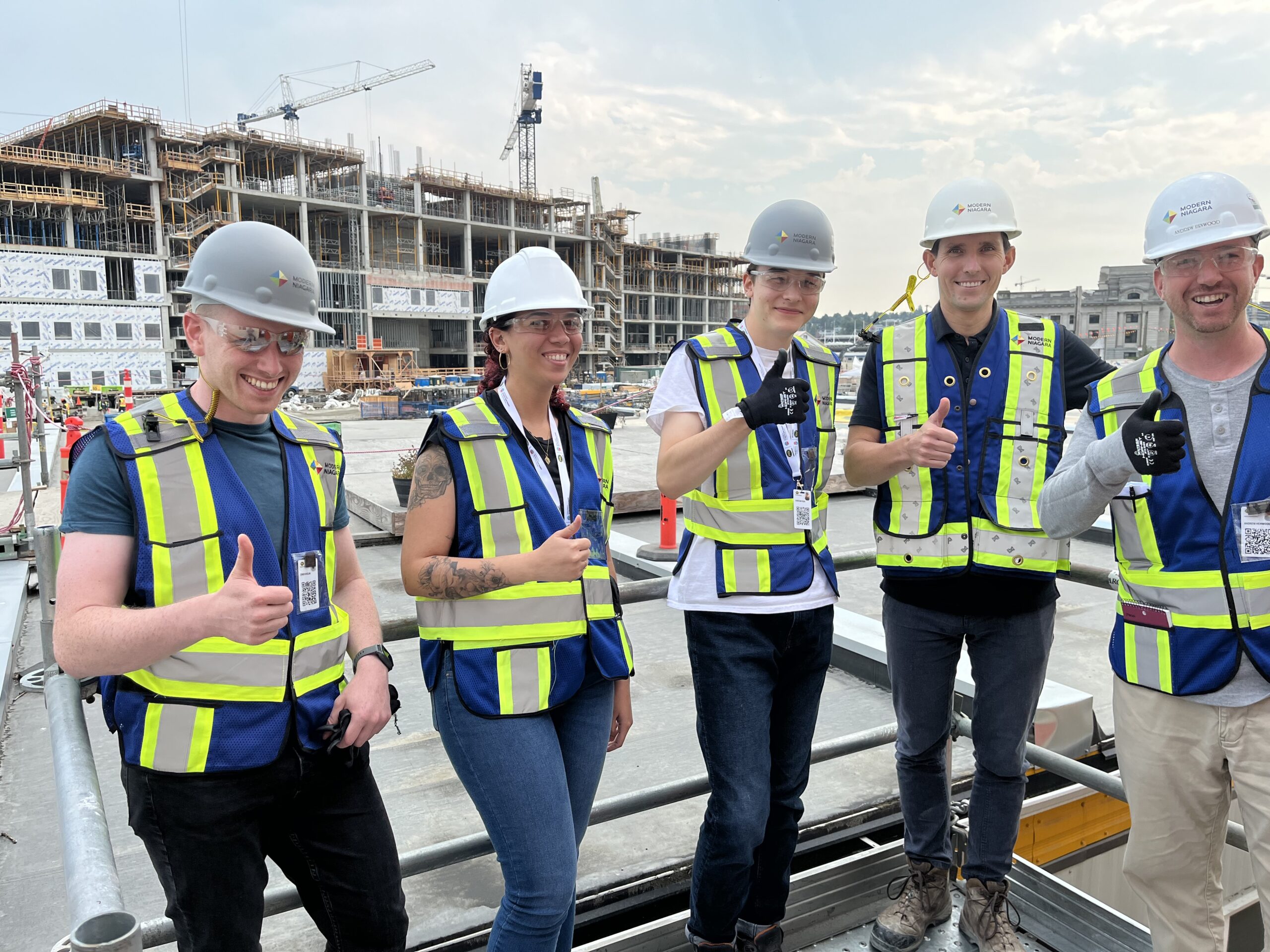
Modern Niagara Vancouver gets handle on ergonomics, pipes down injury rates
October 3, 2023
By
Todd Humber

The Modern Niagara Team in front of the new St. Paul’s Hospital Project in Vancouver.
Best Ergonomics Program
Gold: Modern Niagara Vancouver
Silver: Compass Group Canada
Silver: Ontario Power Generation
Modern Niagara Vancouver noticed a worrisome trend in its injury statistics. The company, which has a focus on plumbing and mechanical work, employs a lot of plumbers and sheet metal workers.
“We’re always working at heights, and we’re always working with sharp tools and materials,” said Ken Brodie, HSE Specialist. “But it appeared that the lion’s share of our injuries were for ergonomic strains.”
The data backed that up and, with a massive project looming, the focus shifted on how to prevent injuries related to musculoskeletal disorders (MSDs) caused by repetitive, forceful, or awkward movements.
“We knew we had to really focus on the ergonomics issue because we were about to begin work on the new St. Paul’s hospital in Vancouver and have up to 500 workers there,” he said. “If we don’t get control of it before then, ergonomic claims would most likely increase in number and severity. Our focus was to stop this — do whatever we had to do and it had to be done right to prevent hip strains, back pain, and knee and shoulder injuries.”
The proactive approach to tackling the issue led to it winning the gold award for Best Ergonomics Program at 2023 OHS Honours. Rather than avoiding the issue, the company saw it as an opportunity to reduce injury rates and improve efficiency.
“Senior management immediately stepped up,” said Brodie. The aim was to implement an ergonomic solution that was effective, impactful, sustainable, and would discourage employees from reverting to ergonomically risky behaviors.
Engineering solutions
Engineering controls were identified as the most effective means to mitigate risks. In the company’s fabrication shop, roller and table systems were installed on all bandsaws and Victaulic pipe joining machines.
Gantry Cranes and electric hoists were colour-coded and placed in strategic locations like welding bays and loading docks. Work-tables were also repositioned to reduce excessive reach, fostering a more neutral working position.
“Before it seemed we were manhandling a lot of the pipes and a lot of the ductwork into the shafts and ceilings,” he said. Now, we pre-fabricate entire systems at our shop and the workers spend much less time in the installation process.”
The company extended its ergonomic interventions to field employees through mechanical, portable lifting devices. These devices optimized the delivery of materials to work areas, improving both safety and operational efficiency.
“The company designed new pipe-storage racks and pipe-carts to deliver the right material to the right place, at the right time, and in a proper manner,” he said.
Ergonomic partnerships and medical attention
Partnerships with ConstructionCare and the BC Construction Safety Alliance were cornerstones of Modern Niagara’s ergonomic initiative.
This alliance provided injured workers with prompt medical assessments and treatments, thereby minimizing the financial and human costs of workplace injuries.
Locations across the Lower Mainland enabled workers to receive same-day physiotherapy and next-day physician assessments, a remarkable feat given the industry standard.
“They said, ‘We can get your workers in at 2 p.m. in five different locations around Greater Vancouver, five days of the week.’ It was perfect, it was exactly what we were looking for,” he said. “Anytime we have an ergonomic strain or injury, they are there to assess and help.”
Employee involvement
Employee engagement was another pillar of Modern Niagara’s ergonomic program.
Employees were encouraged to voice their concerns and suggestions, thereby actively participating in risk reduction, he said.
“Workers involved in ergonomics-related activities within their own field project were able to share their experiences and ideas with our other projects, thus increasing the dissemination of their successes,” said Brodie.
Proof is in the numbers
The program’s effectiveness wasn’t just conceptual; it was quantifiable. Over 29 months, from February 2021 to July 2023, the company recorded only two ergonomic claims despite accumulating over 403,601 man-hours in 2022 alone.
The company’s experience rating also improved noticeably, going from a 27.7% surcharge in 2022 to a -2.2% discount for 2023. The company’s injury rate of 1.1 also compared favorably to the industry average of 4.6 in their classification unit.
Beyond immediate gains
While the program has brought immediate benefits, it is designed for long-term success, said Brodie.
Modern Niagara is committed to ongoing assessments to ensure continuous improvement.
“We continually discuss how our ergonomics process can be improved,” Brodie said, adding that first-aid reports, absenteeism rates, and other indicators are regularly reviewed.